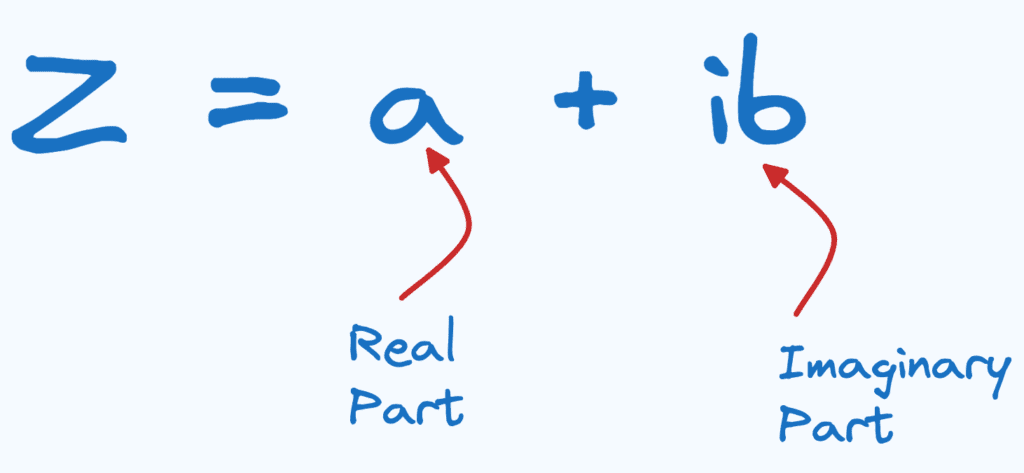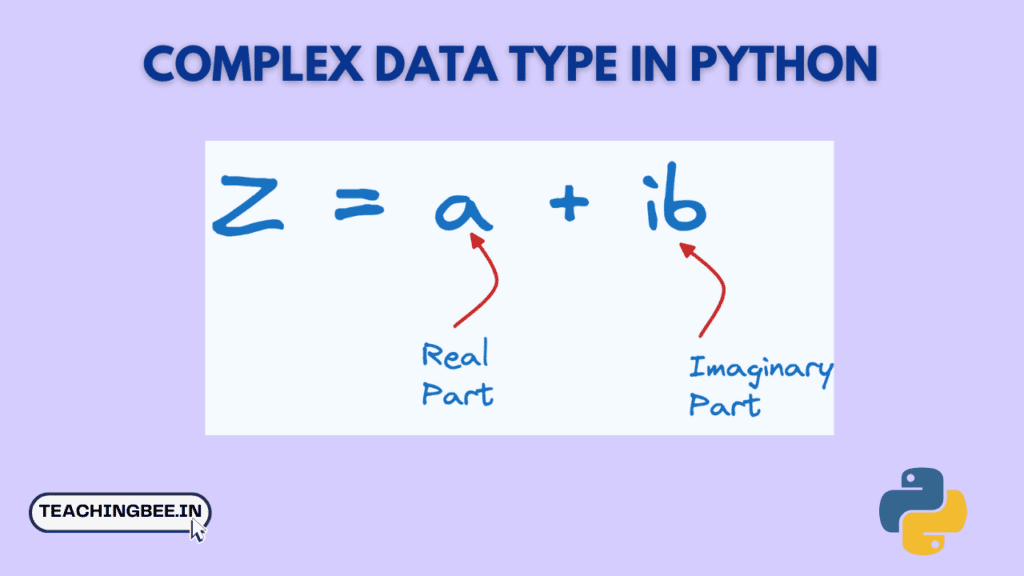Table of Contents
ToggleThe complex() function is an essential building block in Python for working with complex numbers across scientific computing, signal processing, physics, engineering, and more fields. This article provides a comprehensive overview of complex() – from basic creation of complexes to conversions, operations, exceptions handling, and more.
Whether you are new to complex numbers or have experience, this article will help you to solidify both core knowledge and technical best practices for leveraging complex() effectively in code.
What Is A Complex Function In Python?


Complex data type in python represents complex numbers, which consist of a real part and an imaginary part. Complex numbers are written as a + ib, where a is the real component and b is the imaginary component, with i representing the square root of -1. Complex numbers are written in the form:
z = a + ibWhere ‘a’ represents the real part and ‘b‘ represents the imaginary part.
The purpose of the complex() function is to provide a easy way to construct these complex numbers, rather than manually creating them:
x = complex(2, 3) # 2 + 3jProperties of Complex Data Type In Python
- Components: In Python, a complex number has two attributes:
realandimag. These return the real and imaginary parts of the number, respectively. For instance, for the complex numberz = 3 + 5j,z.realis3.0, andz.imagis5.0. - Immutability: Complex numbers in Python are immutable, meaning that once they are created, their values cannot be changed. This is a characteristic they share with other numeric types in Python like integers and floats.
- Arithmetic Operations: Python supports various arithmetic operations with complex numbers, including addition, subtraction, multiplication, and division. These operations can be performed between complex numbers themselves or between a complex number and another numeric type (like
intorfloat). - No Ordering: Complex numbers in Python do not support relational operations like
<,>,<=, and>=. This is because there’s no natural way to order complex numbers as there is with real numbers. - Conjugate Method: The
conjugate()method returns the conjugate of a complex number. For a complex number defined asz = a + bj, the conjugate isa - bj. This method is useful in various mathematical computations involving complex numbers. - Magnitude Calculation: The built-in
abs()function is used to calculate the magnitude (or absolute value) of a complex number. For a complex numberz = a + bj, the magnitude is calculated as the square root of(a^2 + b^2).
These properties make the complex data type in Python a powerful tool for computations in various scientific and engineering applications, where complex numbers are often used.
Syntax of Complex Function In Python
Let’s discuss syntax of complex data type in python.
Parameters
The complex() function can be invoked with either one or two parameters:
complex(a): Creates a complex number with ‘a’ as the real part and 0 as the imaginary part.complex(a, b): Creates a complex number with ‘a’ as the real part and ‘b’ as the imaginary part.
Here ‘a’ and ‘b’ can be integers, floats, or even expressions that evaluate to numbers. This flexibility allows for a wide range of inputs: Fro example:
x = complex(2, 3) # Using integers: 2 + 3j
y = complex(1.2, -4.8) # Using floats: 1.2 - 4.8j
z = complex(a, b) # Using variables or expressionsDefault Values and Return Type
The complex() function intelligently handles omitted parameters:
- If no real part is provided, it defaults to 0.
- If no imaginary part is provided, it also defaults to 0.
This default behaviour means that calling complex() without any arguments results in a complex number representing 0+0j:
x = complex() # Results in 0 + 0jUpon execution, complex() returns a complex number object. This object comes with two accessible attributes:
.real: Retrieves the real part of the complex number..imag: Retrieves the imaginary part of the complex number.
These attributes allow for easy post-creation inspection of the complex number’s components:
x = complex(2, 3)
print(x.real) # Output: 2
print(x.imag) # Output: 3Converting Data Types to Python Complex Numbers
Python not only provides the complex() function for creating python complex numbers but also supports a variety of ways to convert different data types into complex numbers. Moreover, Python allows the use of complex numbers in various operations and functions.
String to Complex Data Type In Python
- Strings containing numeric values formatted as complex numbers (e.g., “2+3j”) can be converted into complex numbers using the
complex()function. - This method parses the string and extracts the real and imaginary parts.
x = complex("2+3j")
print(x.real) # Output: 2
print(x.imag) # Output: 3Integer to Complex Data Type Conversion
Integers can be directly converted to complex numbers, where the imaginary part is set to 0 by default.
x = complex(5)
print(x) # Output: 5 + 0jFloat To Complex Data Type Conversion
Similar to integers, floats are converted to complex numbers with the imaginary part being 0
x = complex(5.2)
print(x) # Output: 5.2 + 0jCreating Python Complex Numbers without complex()
Complex numbers in Python can also be created using normal arithmetic operations. This method uses multiplication by 1j (the imaginary unit) to create the imaginary part:
real = 2
imag = 3
z = real + imag * 1j
print(z) # Output: 2 + 3jThis approach is useful for dynamically creating complex numbers based on variable values or expressions.
Arithmetic Operations With Complex Data Type In Python
Python’s handling of complex numbers extends to a wide range of arithmetic operations, allowing for both basic and advanced manipulations. These operations follow the mathematical rules of complex numbers and are implemented in a way that is both intuitive and efficient.
Addition and Subtraction
- Python performs these operations component-wise, separately for the real and imaginary parts.
- For example, when adding or subtracting two complex numbers, the real parts are added or subtracted, and the imaginary parts are similarly combined.
a = 2 + 3j
b = 5 + 4j
# Addition
c = a + b # 2+3j + 5+4j = (2+5) + (3+4)j = 7 + 7j
# Subtraction
c = a - b # 2+3j - 5+4j = (2-5) + (3-4)j = -3 - 1jMultiplication and Division
These operations also treat the real and imaginary components separately but follow the algebraic rules for complex numbers.
# Multiplication
c = a * b # Complex multiplication
# Division
c = a / b # Complex divisionFinding the Conjugate
- The conjugate of a complex number is obtained by flipping the sign of its imaginary part.
- This operation is frequently used in complex number calculations, especially in fields like signal processing and quantum mechanics.
a = 2 + 3j
conjugate = a.conjugate() # Results in 2 - 3jCommon Exceptions in Using complex()
TypeError
- This occurs when the arguments passed to
complex()are not numeric or are of an unsupported type. - Common scenarios include passing strings that do not represent numeric values or other non-numeric data types like lists.
# Passing a non-numeric string
x = complex("test")
# TypeError: complex() can't take second arg if first is a string
# Passing a non-numeric data type like a list
x = complex([2, 3])
# TypeError: complex() argument must be a string or a number, not 'list'In these cases, ensuring that the inputs to complex() are either numeric values or strings representing numeric values is crucial.
ValueError
- This error is raised when a string passed to
complex()is not properly formatted to represent a complex number. - The string must contain numeric values followed by ‘j’ or ‘J’ to represent the imaginary part.
x = complex("2+3k")
# ValueError: complex() arg is a malformed stringTo avoid this, ensure that the string correctly represents a complex number, with the imaginary part denoted by ‘j’.
OverflowError
- This error occurs when the numeric values exceed the maximum floating-point precision that Python can handle.
- Python’s maximum float size is system-dependent but often around 1e308.
x = complex(1e500)
# OverflowError: complex divmod()This error can be mitigated by staying within the range of acceptable numeric values for complex numbers.
Key Takeaways
- The complex() function returns a complex number object, with real and imaginary attributes for later access. Handy defaults make creation straightforward.
- Converting integers, floats, strings and more data types to complex is trivial – no complex() constructor needed in many cases.
- Complex math operations from addition to conjugates follow intuitive rules – happening separately on real and imaginary components.
- Common exceptions like TypeErrors and OverflowErrors can occur, but are avoidable and debuggable with care around input.
- Complex numbers unlock specialized mathematical capabilities like rotations and signal transformations that pay dividends across science/engineering use cases.
- Languages like Python make utilization of complexes easy via functions like complex() – opening doors to advanced applications.
Also Read
I hope You liked the post 👍. For more such posts, 📫 subscribe to our newsletter. Try out our free resume checker service where our Industry Experts will help you by providing resume score based on the key criteria that recruiters and hiring managers are looking for.
FAQ
What is meant by complex data type?
A complex data type represents complex numbers with real and imaginary parts for sophisticated mathematical computations.
What is simple and complex data type?
Simple data types in Python include integers, floats, and strings that represent basic singular values, while complex data types like Python’s complex number objects have internal components like real and imaginary parts.
What are the valid complex data types in Python?
The main complex data type is the complex number object constructed with the complex() function, taking numeric values or strings for the real and imaginary parts.




